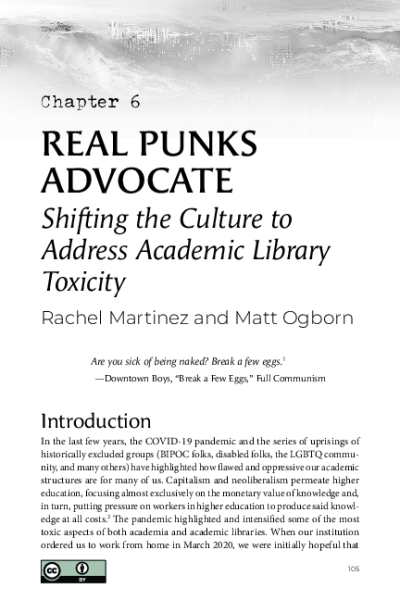Filtering by
- Peer-reviewed: Peer-reviewed

This document details a conceptual Framework for the Certification of Carbon Sequestration (FCCS). It is based on a system designed to support negative emissions. It provides the minimum requirements for the development of carbon sequestration standards and certificates of carbon sequestration. It allows the certification of standards so that they in turn produce certification of removed carbon that authenticates durability and verifiability. The framework (i) identifies an organizational structure for the certification system, (ii) clarifies the responsibility of participating entities, (iii) provides certificate designs and usages, (iv) details the requirements to develop measurement protocols, (v) provides mechanisms to support a long-term industry, and (vi) outlines a vision towards durable storage.

The Mixtec pictorial manuscript, now known as the Codex Tonindeye, was stolen from an Italian monastery library in 1859. Several decades later, the Mexican American anthropologist Zelia Nuttall located the document after many years of searching. Determined to reinstate its historical identity, Nuttall closely studied the codex and reproduced it in a lush facsimile; it was named the Codex Nuttall (1902) in her honor. Using Nuttall’s correspondence with her publishers at the Peabody Museum, this article investigates the role of archives and museums in nineteenth-century textual scholarship, explores how Nuttall relocated the codex and labored over creating the facsimile, and addresses the ongoing importance of the document.

The Journal of Surrealism and the Americas: Vol. 12 No. 1 (2021) - Table of Contents
"Introduction, Special Issue on Fashion" by Jennifer R. Cohen, Michael Stone-Richards, pp. 1-5
"Fashion in the Formative Years of Parisian Surrealism: The Dress of Time, the Dress of Space" by Krzysztof Fijalkowski, pp. 6-32
"Surrealist Shop Windows: Marketing Breton’s Surrealism in Wartime New York" by Jennifer R. Cohen, pp. 33-59
"Object Study: Binding Saint Glinglin" by Jenny Harris, pp. 60-77
"‘Always for Pleasure’: Chicago Surrealism and Fashion, An Interview with Penelope Rosemont" by Abigail Susik, pp. 78-92
"Sade for the Brave and Open-Minded: Review of Alyce Mahon, The Marquis de Sade and the Avant-Garde" by Joyce Cheng, pp. 93-99
"Review of Henri Behar, Potlatch, André Breton ou la cérémonie du don" by Pierre Taminiaux, pp. 100-103

Cities in the Global South face rapid urbanization challenges and often suffer an acute lack of infrastructure and governance capacities. Smart Cities Mission, in India, launched in 2015, aims to offer a novel approach for urban renewal of 100 cities following an area‐based development approach, where the use of ICT and digital technologies is particularly emphasized. This article presents a critical review of the design and implementation framework of this new urban renewal program across selected case‐study cities. The article examines the claims of the so‐called “smart cities” against actual urban transformation on‐ground and evaluates how “inclusive” and “sustainable” these developments are. We quantify the scale and coverage of the smart city urban renewal projects in the cities to highlight who the program includes and excludes. The article also presents a statistical analysis of the sectoral focus and budgetary allocations of the projects under the Smart Cities Mission to find an inherent bias in these smart city initiatives in terms of which types of development they promote and the ones it ignores. The findings indicate that a predominant emphasis on digital urban renewal of selected precincts and enclaves, branded as “smart cities,” leads to deepening social polarization and gentrification. The article offers crucial urban planning lessons for designing ICT‐driven urban renewal projects, while addressing critical questions around inclusion and sustainability in smart city ventures.`

Since 2018, MMM team members have written sport-style summaries following the live "play-by-play" narration of simulated combatant encounters on social media. These summaries, highlighting key adaptations, human impacts, and other scholarly information, have been provided to educators to describe tournament outcomes to their learners who do not follow the battle narrations "live" on social media.

Sustainable mobility policy for long-distance transportation services should consider emerging automobiles and aircraft as well as infrastructure and supply chain life-cycle effects in the assessment of new high-speed rail systems. Using the California corridor, future automobiles, high-speed rail and aircraft long-distance travel are evaluated, considering emerging fuel-efficient vehicles, new train designs and the possibility that the region will meet renewable electricity goals. An attributional per passenger-kilometer-traveled life-cycle inventory is first developed including vehicle, infrastructure and energy production components. A consequential life-cycle impact assessment is then established to evaluate existing infrastructure expansion against the construction of a new high-speed rail system. The results show that when using the life-cycle assessment framework, greenhouse gas footprints increase significantly and human health and environmental damage potentials may be dominated by indirect and supply chain components. The environmental payback is most sensitive to the number of automobile trips shifted to high-speed rail, and for greenhouse gases is likely to occur in 20–30 years. A high-speed rail system that is deployed with state-of-the-art trains, electricity that has met renewable goals, and in a configuration that endorses high ridership will provide significant environmental benefits over existing modes. Opportunities exist for reducing the long-distance transportation footprint by incentivizing large automobile trip shifts, meeting clean electricity goals and reducing material production effects.

March Mammal Madness is a science outreach project that, over the course of several weeks in March, reaches hundreds of thousands of people in the United States every year. We combine four approaches to science outreach – gamification, social media platforms, community event(s), and creative products – to run a simulated tournament in which 64 animals compete to become the tournament champion. While the encounters between the animals are hypothetical, the outcomes rely on empirical evidence from the scientific literature. Players select their favored combatants beforehand, and during the tournament scientists translate the academic literature into gripping “play-by-play” narration on social media. To date ~1100 scholarly works, covering almost 400 taxa, have been transformed into science stories. March Mammal Madness is most typically used by high-school educators teaching life sciences, and we estimate that our materials reached ~1% of high-school students in the United States in 2019. Here we document the intentional design, public engagement, and magnitude of reach of the project. We further explain how human psychological and cognitive adaptations for shared experiences, social learning, narrative, and imagery contribute to the widespread use of March Mammal Madness.

Attitudes and habits are extremely resistant to change, but a disruption of the magnitude of the COVID-19 pandemic has the potential to bring long-term, massive societal changes. During the pandemic, people are being compelled to experience new ways of interacting, working, learning, shopping, traveling, and eating meals. Going forward, a critical question is whether these experiences will result in changed behaviors and preferences in the long term. This paper presents initial findings on the likelihood of long-term changes in telework, daily travel, restaurant patronage, and air travel based on survey data collected from adults in the United States in Spring 2020. These data suggest that a sizable fraction of the increase in telework and decreases in both business air travel and restaurant patronage are likely here to stay. As for daily travel modes, public transit may not fully recover its pre-pandemic ridership levels, but many of our respondents are planning to bike and walk more than they used to. These data reflect the responses of a sample that is higher income and more highly educated than the US population. The response of these particular groups to the COVID-19 pandemic is perhaps especially important to understand, however, because their consumption patterns give them a large influence on many sectors of the economy.


Chapter from the ACRL book Toxic Dynamics: Disrupting, Dismantling, and Transforming Academic Library Culture. This chapter provides a bit of background on punk and libraries, identifies some toxic library cultures, and then suggests concrete ways for library workers to disrupt these cultures while maintaining boundaries that are regularly violated in library work.